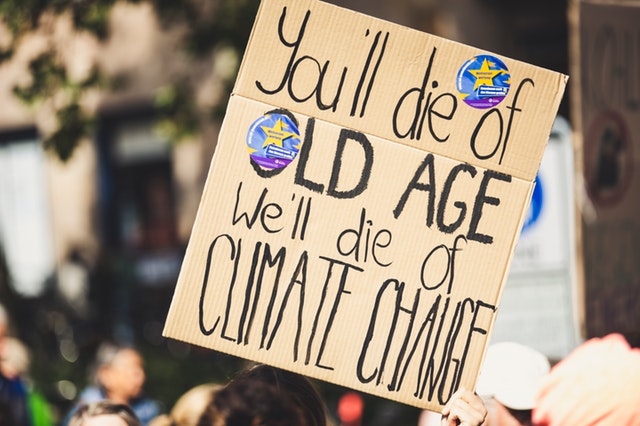
Nature has a big problem.
Too few of us believe that climate change will happen here or will affect us personally if it does. But these misperceptions are only one aspect of the problem.
Too many decision makers–and too many workers caught in the cross-hairs of the debate–still believe that the costs of changing how we consume, digest and expel the world’s resources are too high for the benefits that might be realized once we start paying for them. They don’t see “the benefit of the bargain” I see (and maybe you see) so clearly, only their share of an unacceptable price tag.
And indeed, the high costs of changing how we do things today tend to crop up everywhere in the climate change debate.
If we want to stop over-fishing, there are the costs to the livelihoods of the fishermen. If we want to reduce our reliance on carbon-based energy, there are the impacts on those who build and maintain today’s energy infrastructure, and on the communities that depend on those workers and suppliers. It’s dismantling one economy—the lost jobs and abandoned investments—for a new one whose economic upsides often seem to be worth less than the high costs of changing how we do things now.
In market-based economies, the challenge is proving that these transition costs will be justified by the long-term economic gains. A rough apples-to-apples type exchange between likely benefits and likely costs needs to be argued, presented and accepted by enough stakeholders for “the human family” to “voluntarily” undertake the expensive steps that are necessary to confront climate change.
Put another way: will the “value” of a healthier planet tomorrow cover the “costs” of ensuring it today? Perhaps the biggest challenge facing those of us who are alarmed by climate change is filling in the “quotation marks” in this cart-before-the-horse equation so we can convince the many hold-outs who still need convincing. But until now, we’ve mostly failed to do so.
Only quite recently have the number crunchers begun to calculate the cost benefits of a healthier planet that will, over time, offset the costs of ensuring it today. It’s the dollar-spent for dollar-earned scenario that is essential if we’re to turn climate change advocacy into meaningful action.
In the places where we work, most supporters that we’ll need to realize our visions start out skeptical if not flat-out opposed to the better worlds we can often “see” so clearly, so we need to translate our versions of both the problems and solutions into stories they can understand. Like it or not, that’s usually the economic story where we trade tangible costs for tangible benefits as we undertake the often painful changes that will be needed along the way. It works almost every single time, but until now that story has not been properly told in the struggle to confront climate change.
Well the time to start telling it is now.
The Economic Benefits of Whales Versus the Lobstermens’ Costs to Protect Them
According to a recent story, there’s been an on-going showdown between lobstermen and environmentalists off the coast of Maine. The point of controversy is right whales that environmentalists argue are dying when they get caught in the lines that secure local lobster pots. The whales are threatened with extinction. The lobster industry, which is already undermined by warming waters, will be further crippled by putting down fewer pots or otherwise reducing the number of lines that secure them.
Is there a way that the value of having more whales in this ecosystem might cover the high costs that lobstermen, their families and their coastal communities will have to incur to protect them?
Until quite recently, I would have said “no.” But before finding a better answer, it might help to have some additional background about the Gulf of Maine controversy.
The right whales got their name because they were the “right” whales to push towards extinction with our commercial activities, first with the harpoons of whaling boats and more recently by accidentally slaughtering them with boat propellers, fishing nets and lobster pot lines. These bus-sized mammals are slow moving and “built by evolution to be oblivious forage feeders,” according to a NOAA Fisheries’ official. It makes these whales unusually susceptible to getting ensnared and killed.
NOAA estimates that today’s population of right whales is only about 400, with fewer than 95 breeding females remaining, which means that the entire population is jeopardized by a single death each year. But more than 30 of these whales have been found dead since 2017. While the reason for these fatalities isn’t always clear, it does not appear that they are dying from natural causes according to investigators.
To address the problem, NOAA has proposed new regulations to clear fishing lines from the whales’ path. While the regs will cover all New England waters, Maine lobstermen, who “dangle more than 800,000 lines from buoys to ocean-floor traps in their busiest months,” clearly have the most at stake. To satisfy the proposed standards, they will need to remove at least half of those lines from the water. Says one lobsterman in blunt response: “We don’t want to go extinct either.” In addition to 4,800 harvesters working these waters, the lobster industry supports thousands more jobs on shore while contributing $1.5 billion a year to the state’s economy.
During the rule making period that we’re in today, scientists will be arguing about whether the proposed regulation goes far enough to protect the whales while those alarmed by its likely impacts will be making their case for reasonable accommodations or to reject the new restrictions altogether.
As tensions escalate, and opponents refine the dollar amounts that are likely to be lost if NOAA’s regulation goes into effect, it seems a useful time to ask whether anyone in that debate is calculating the economic benefit that is provided to Maine (and indeed to all of us) by the survival of these whales.
Is anyone enabling an apples-to-apples comparison of costs and benefits so that both sides in this controversy are (more or less) in the same ballpark, with the opportunities for tradeoffs and compromises that “speaking the same economic language” might allow?
And beyond that, is there a way that the “value” of preserving these whales can cover the costs that will have to be borne by these communities if they can ever come together to protect them?
The Startlingly High Value of a Whale
In the past week or so, I came upon another whale story. This one involved a team of visionaries at the International Monetary Fund (IMF).
As is often the case, I overheard bits of the story in a Morning Edition segment on NPR, which took me to a story that had been published that day in National Geographic, and eventually to a much deeper analysis in an IMF publication. It was worth getting to the bottom of the story.
As far as I can tell, what the IMF team discovered about whales and ended up proposing for the sake of both nature and industry was not in response to the Gulf of Maine controversy, but it could certainly help to resolve it.
The IMF’s approach considered all the whales in the world’s oceans. Because of its boldness and breadth, it could make a significant enough dent in species degradation, at a rapid enough pace, to reduce the number of ocean-based harms that we can no longer repair. At the same time, its approach would utilize the whales’ enormous environmental “value” to help compensate the global fishing and transportation industries for the costs of adopting “whale saving” practices. Here in a nutshell is their argument (although I urge you to read the entire IMF article and to enjoy the visualizations they’ve included in it).
Essentially, the IMF team realized that a whale’s economic value comes from its extraordinary ability to capture and then sequester carbon. “When it comes to saving the planet,” they write, “one whale is worth thousands of trees.”
In building their economic analysis, the team relied on 2014 research about how whales remove (and help others to remove) carbon from the environment as well as upon international programs that have developed mechanisms to fund the preservation of carbon capturing eco-systems. The team’s signature innovation may be focusing on a particularly helpful as well as beloved animal to support this kind of cost-benefit analysis on a truly global scale.
According to prior research, a whale sequesters as much as 33 tons of carbon dioxide per year on average compared to only 48 pounds per land-based tree. Whales eat phytoplankton, which not only contribute at least 50 percent of the oxygen in the earth’s atmosphere but in doing so also capture 37 billion metric tons of carbon dioxide or 40 percent of the entire amount that is produced globally each year.
Whales have what the IMF team call “a multiplier effect” on the phytoplankton when they eat them and produce waste products (primarily iron and nitrogen) because these waste products are precisely what is needed for more plankton to grow. As they dive and rise again to the surface, whales “pump” these minerals to the surface across their vast migration patterns, increasing both the amount of plankton and the whale populations that feed on them as long as the whales can do so in relative safety. Moreover, when whales die, the carbon they have sequestered in their enormous bodies from eating plankton in the first place descends to the ocean floor and (according to the National Geographic’s coverage of the IMF plan) “is taken out of the atmosphere for hundreds to thousands of years, a literal carbon sink.”
Of course, whale populations would need to recover significantly to produce the greatest benefits. Continuing their “if-then” analysis, the IMF team notes:
If whales were allowed to return to their pre-whaling number of 4 to 5 million—from slightly more than 1.3 million today—it could add significantly to the amount of phytoplankton in the oceans and to the carbon they capture every year. At a minimum, even a 1 percent increase in phytoplankton productivity thanks to whale [pumping] activity would capture hundreds of millions of tons of additional C02 a year, equivalent to the sudden appearance of 2 billion mature trees. Imagine the impact over the average lifespan of a whale, more than 60 years.
(To put these benefits in a slightly different context, National Geographic cites economists’ calculations showing that these great whales alone could either capture or help more plankton to capture 1.7 tons of C02 per year, which is more than the annual carbon emissions of Brazil today.)
The question, then, is how to restore whale populations to pre-whaling levels. Those causing the current threat include nations that still allow whale hunting, industries (like fishing and ocean going transport of people and goods) that jeopardize migrating whales, as well as the actions of individual fishermen. Without covering the very real costs of changing these practices, it is nearly impossible to imagine that the necessary changes will be undertaken voluntarily.
With the aim of meeting these costs, the IMF team made “conservative estimates” of each whale’s value. For the largest so-called “great whales,” they used science-based estimates of how much CO2 each one sequesters directly or indirectly in its lifetime along with CO2’s market price. To this base number, they added value for a whale’s other economic contributions, including fishery enhancement and ecotourism. The IMF team concluded that the value of the average great whale is more than $2 million and that the current value of the global stock of great whales alone “is easily over $1 trillion.”
By using this “value” essentially as collateral for raising the necessary funds, monies would become available (from environmentally oriented companies, non-profits, consumers and even countries) to compensate those who are likely to suffer economic losses by changing their current business practices to protect the whales. “For example,” the team notes, “shipping companies could be compensated for the cost of altered shipping routes to reduce the risk of [whale] collisions.”
What is perhaps most noteworthy about the IMF team’s “good work” is the change in mindset that their cost-benefit analysis invites to help resolve one of our most challenging global problems: the seemingly irreconcilable conflict between nature and industry until now. The team recognized that the necessary changes will never be made unless those incurring those costs can be paid and the world can unite around sufficient compensation mechanisms to ensure that they are. Finding new ways to “value” and “leverage” nature (or “earth-tech,” as they call it) is the key they have identified.
+ + +
What the IMF team proposes doesn’t fit into a tidy package as yet, and a myriad of details still has to be worked out. In other words, the economic benefits from nature and the costs to industry of protecting it are not quite apples-to-apples yet. But this proposal boldly offers a new approach to balance the needs of both nature and industry on a global scale.
While it’s a financing mechanism that’s aimed only at whales, it introduces a framework for thinking about other carbon-rich ecosystems like sea grass beds or the forest elephants of the Congo River basin.
Proposing an earth-tech solution instead of an artificial, man-made one is inspired for another reason. When I worked in the energy industry, I studied carbon sequestration plants that were being developed at the time and know first-hand about both the technology challenges and the prohibitive expense of these man-made solutions. By contrast, nature can perform much of the same work “naturally,” if only we’d let it.
And for the on-going battle between the right whales and the lobster industry in the Gulf of Maine, there is now a rudimentary framework that, with imagination and a sense of urgency, may actually be able to serve both of them.
Good work often achieves its loftiest objectives by finding new ways to confront the dollars-and-cents obstacles that are right in front of it.
This post was adapted from my October 13, 2019 newsletter. When you subscribe, a new newsletter/post will be delivered to your inbox every Sunday morning.







